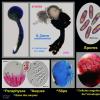
24-12-2025 17:08
Hulda Caroline HolteHello, I have found this propoloid ascomycete on

21-12-2025 09:32
Hello.A tiny ascomycete found embedded in wood in

21-12-2025 21:32
Pol DebaenstHello, Garden, Burgweg 19, Veurne, BelgiumOn 10/1

22-12-2025 23:38
Patrice TANCHAUDBonsoir, récolte sur un mur en pierre, apothéci

22-12-2025 00:47
Patrice TANCHAUDBonsoir, récolte à proximité du milieu dunaire
Asco inconnu
Roland Labbé,
18-02-2009 21:54
Voici une planche d'un Asco qui m'est ocmplètement inconnu, possiblement un Plectomycète ?
Merci de bien vouloir me renseigner sur l'espèce en question.
Détails :
Date de récolte: 2009 / 02 / 17
Substrat : culture intérieure sur bûche décomposée d’érable rouge, possiblement sur très vieux Hypoxylon ?
Sporée absente
Cleisthothèce probable porté par un pied ?
Spores cylindriques, lisses, avec 2 grosses guttules polaires, apparemment non septées, possiblement avec un étranglement central à maturité, 10-12 x 3 µm, 10,6 x 3 µm en moyenne (10 spores), Q = 3,53
Asques à 8 spores bisériées, avec appareil apical non amyloïde, 50-65 x 6-8 µm
Paraphyses longuement fusoïdes-lancéolées, à paroi très mince difficile à observer, possiblement septées vers la base, hyalines, dépassant les asques de ± 30 µm
David Malloch,
19-02-2009 02:22

Re:Asco inconnu
This looks like a perithecium of one of the Diaporthaceae. The apparent stalk may be a long perithecial neck like in species of Gnomonia. The asci do not look like they belong to a plectomycete because they are elongated and appear capable of forcible spore discharge. Is it possible that the perithecium was removed from a stromatic group as in Cryptodiaporthe?
